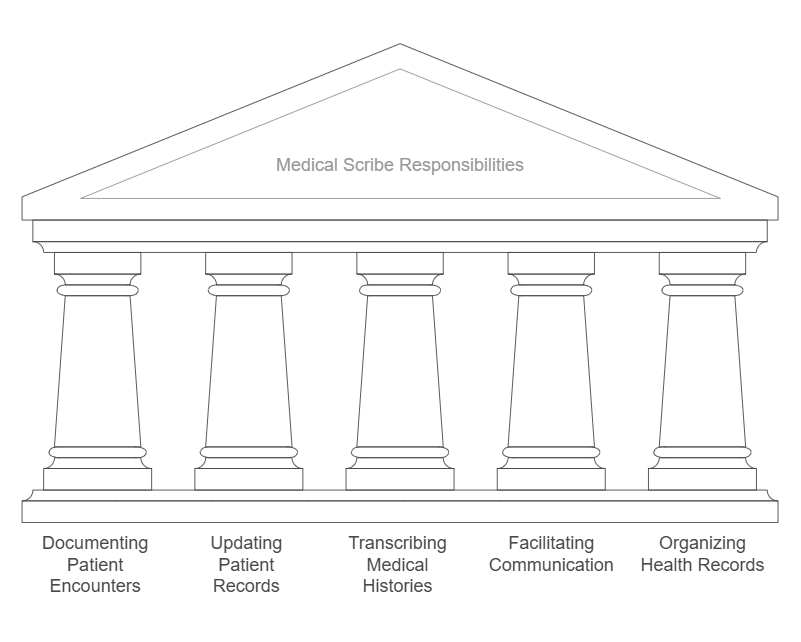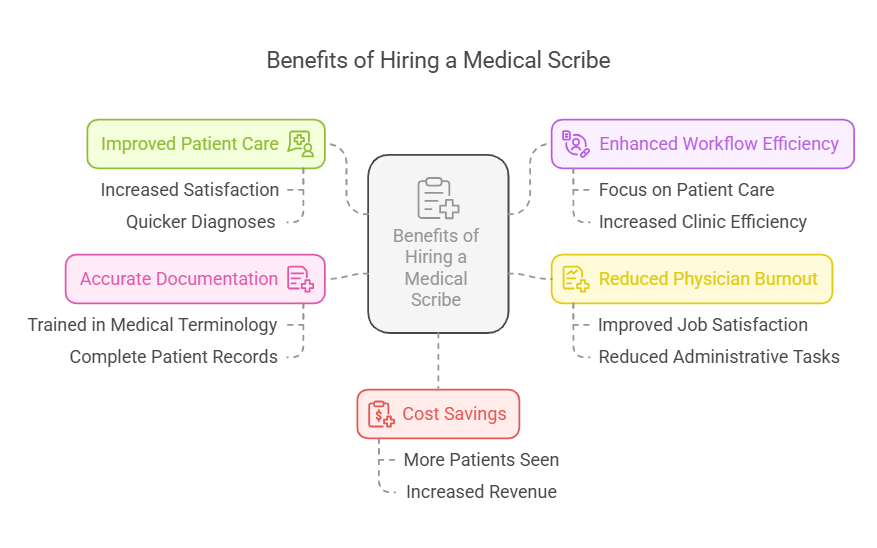What does a Medical Scribe do? Role & Responsibilities 2025
Picture this: You’re a doctor, ready to save lives, but there’s a mountain of paperwork standing in your way. Enter the medical scribe! They’re like your right-hand superhero—except they don’t wear a cape (or at least, not on official hours). In today’s fast-paced healthcare world, scribes are the unsung heroes, allowing doctors to focus more on patient care and less on the dreaded paperwork. In this blog, let’s dive into the exciting world of medical scribes, from their roles and responsibilities to how you can become one in 2025!
Medical scribes are like backstage managers in the medical world. While doctors focus on the patient’s health, scribes handle the administrative burdens that come with modern healthcare systems. They assist healthcare providers in efficiently documenting patient encounters, creating a smoother workflow that allows physicians to dedicate more time to their patients. Their role is rapidly evolving in response to technological advancements, rising healthcare demand, and the need for improved patient outcomes.
Whether you're considering a career in medical scribing or simply want to understand the essential role these professionals play in the healthcare ecosystem, this guide will cover it all—from the core duties of a medical scribe to their career prospects and challenges.
Medical Scribe Role & Responsibilities: The Nitty-Gritty
Now that we know what a medical scribe is, let’s take a closer look at their key responsibilities. Understanding these duties is essential for anyone looking to pursue a career in medical scribing or to better understand the value these professionals bring to the healthcare system.
1. Documenting Patient Encounters
One of the primary responsibilities of a medical scribe is documenting patient encounters during consultations. This means transcribing everything from medical histories to treatment plans and follow-up care. The scribe must listen to the physician’s notes during patient visits and quickly input them into the EHR system while ensuring that the data is accurate and complete. This live documentation is crucial for providing real-time medical information that can be used by other healthcare professionals involved in the patient's care.
Related Blog: Why Is Documentation Vital in Medicine?
For example, during a doctor’s appointment, a medical scribe would be responsible for recording the patient's medical history, symptoms, diagnosis, and treatment plan as the physician speaks with the patient. They ensure that the information entered is clear, concise, and properly formatted for easy retrieval later.
2. Updating Patient Records
Medical scribes are responsible for maintaining and updating patient records. This involves inputting lab results, imaging studies, and prescription details, as well as tracking changes in the patient’s health status over time. Scribes are often tasked with ensuring that records are complete, organized, and up to date to ensure continuity of care.
In some cases, scribes may be required to check in with patients about previous tests or medications and update the patient’s records accordingly. This helps to ensure that healthcare providers have a comprehensive understanding of the patient's history and current condition.
3. Transcribing Medical Histories
Medical scribes play a crucial role in transcribing medical histories during consultations. This includes noting previous diagnoses, surgeries, allergies, and any ongoing health issues. Scribes ensure that these details are accurately recorded so that the physician can review them and make informed decisions about the patient’s care.
Transcribing medical histories is not just about writing down what the patient says. Scribes must also ensure that they are using the correct medical terminology and ensuring the documentation reflects the physician’s assessments and conclusions.
4. Facilitating Communication
While scribes primarily focus on documentation, they also play a role in facilitating communication within the healthcare team. By ensuring that patient data is accurately recorded and easily accessible, scribes help ensure that all healthcare providers involved in the patient’s care are on the same page. This is especially important in hospitals and clinics where multiple specialists might be involved in a single patient’s treatment.
In addition to handling data, scribes may help clarify questions or concerns that arise during patient visits, ensuring that the physician has all the necessary information to make decisions quickly.
Related Blog: Teamwork's Role in Medical Scribing: Enhance Patient Care
5. Organizing and Managing Health Records
Scribes are tasked with managing both digital and, in some cases, physical health records. Their role involves organizing information in a way that makes it easy for physicians and other healthcare providers to access when needed. Proper documentation and record management are vital for maintaining continuity of care and ensuring that patients’ health information is available in a timely manner.
Benefits of Having a Medical Scribe
Hiring a medical scribe brings several advantages to both healthcare providers and patients. Here are some of the key benefits:
Improved Patient Care
By reducing the amount of time doctors spend on documentation, scribes enable physicians to spend more time interacting with their patients. This leads to better care, increased patient satisfaction, and quicker diagnoses.Enhanced Workflow Efficiency
Medical scribes streamline processes by handling time-consuming tasks like documentation, allowing healthcare providers to focus on what matters most: patient care. This increases overall clinic or hospital efficiency.Reduced Physician Burnout
Physician burnout is a growing issue, often caused by the high volume of paperwork and administrative tasks physicians have to handle in addition to patient care. Scribes help alleviate these burdens, reducing burnout and improving job satisfaction.Accurate Documentation
Medical scribes are highly trained in medical terminology and documentation, ensuring that patient records are accurate and complete. This is crucial for patient safety, as accurate records help prevent errors in diagnosis and treatment.Cost Savings
By improving efficiency and reducing physician burnout, medical scribes can contribute to significant cost savings in healthcare organizations. With more time for patient care, physicians can see more patients, ultimately increasing revenue for clinics and hospitals.
Challenges Faced by Medical Scribes
Despite the many benefits, medical scribes face several challenges in their roles. Understanding these challenges is essential for those considering a career in medical scribing or those who want to appreciate the difficulties these professionals overcome:
1. Managing Workload
Medical scribes often work in fast-paced environments, especially in high-volume hospitals or clinics. They are required to manage a large amount of documentation in real-time, which can be stressful during busy hours. The ability to stay organized and maintain focus is crucial for scribes, especially when working with multiple patients.
2. Maintaining Confidentiality
Given that scribes handle sensitive patient information, they must adhere to strict confidentiality regulations such as the Health Insurance Portability and Accountability Act (HIPAA). This means that scribes must be highly diligent in ensuring that patient data is kept private and secure.
3. Medical Terminology Complexity
While scribes are trained in medical terminology, they often encounter new terms or highly specialized language that can be difficult to understand and accurately transcribe. Ongoing training and experience are necessary to keep up with the ever-evolving medical language.
4. Adapting to Technology
With the rapid advancement of healthcare technology, scribes must stay updated on new EHR systems, speech recognition software, and other tools used in medical documentation. This can be a challenge for some scribes, especially when transitioning to new technologies.
Career Opportunities and Growth in Medical Scribing
The medical scribe profession is booming, and the demand for qualified scribes is on the rise. The healthcare industry is experiencing an increasing need for professionals who can help streamline administrative tasks and improve efficiency. Here’s a closer look at the career opportunities available for medical scribes:
1. Specialization Opportunities
Many scribes choose to specialize in particular fields of medicine, such as emergency medicine, cardiology, or oncology. Specializing allows scribes to gain in-depth knowledge of a specific area of healthcare, which can lead to higher salaries and job security.
2. Technological Integration
With the growing use of AI and machine learning in healthcare, scribes are increasingly working with cutting-edge technology. AI-assisted tools, like automated transcription software and predictive analytics, are improving the efficiency of medical scribing and opening up new opportunities for growth.
3. Growth into Leadership Roles
Experienced scribes have the potential to move into supervisory or managerial roles. They can manage teams of scribes, train new hires, and assist with the development of documentation protocols. Leadership positions often come with higher salaries and greater job stability.
10 Lesser-Known Facts About Medical Scribing
Scribes Can Work Virtually
The rise of telemedicine has allowed medical scribes to work remotely, assisting physicians with virtual consultations. Learn more about virtual scribes.Scribes Help Reduce Waiting Times
By documenting patient information during the consultation, scribes help reduce wait times for patients in the office. Discover how scribes streamline workflows.Scribes Improve Documentation Accuracy
Their attention to detail ensures that all patient data is accurately recorded, reducing errors and improving patient safety. Read about the role of virtual scribes in documentation.Scribes Can Be Certified
Although certification is not required, becoming a certified medical scribe can boost your career prospects. (No specific link available for certification benefits.)Scribes Are an Integral Part of the Healthcare Team
While they don’t treat patients, scribes play an essential role in supporting doctors and improving healthcare delivery. Understand the role of scribes in healthcare.Training Can Be Fast
Many scribe training programs are completed in just six months, making it a relatively quick career path.Medical Scribing Can Lead to Other Healthcare Roles
Many medical scribes go on to become nurses, physician assistants, or even doctors.Scribes Help with Billing and Coding
Some scribes assist with medical billing and coding, further contributing to the efficiency of healthcare organizations.Scribes Are in High Demand Globally
The need for medical scribes is growing worldwide, with countries like Canada and Australia adopting the role.Scribes Help Improve Physician Productivity
By handling administrative tasks, scribes help physicians see more patients, ultimately boosting clinic or hospital revenue. See how scribes enhance productivity.
Conclusion
In conclusion, medical scribes play an indispensable role in modern healthcare. They streamline workflows, reduce physician burnout, and contribute to improved patient outcomes. As healthcare continues to evolve, the demand for skilled medical scribes is expected to grow, and technological advancements will only make the profession more exciting and efficient.
For those looking to start a career in medical scribing, the best place to get certified is ACMSO. They offer the best Medical Scribe Certification program that can set you on the path to success!
-
While no strict educational requirements exist, having a background in healthcare or life sciences, along with proficiency in medical terminology, is often preferred.
-
On average, medical scribes earn between $30,000 and $50,000 annually, depending on experience, location, and specialization.
-
Yes, there are online training programs available for aspiring scribes. These programs often include virtual instruction and hands-on practice with EHR systems.
-
Medical scribes work in real-time with physicians during patient visits, while medical transcriptionists typically transcribe audio recordings of doctor-patient interactions after the fact.
-
It typically takes between 6 months to a year to complete a medical scribe certification program.
-
Absolutely! With experience, scribes can move into supervisory roles or specialize in certain medical fields, which leads to better pay and opportunities.





